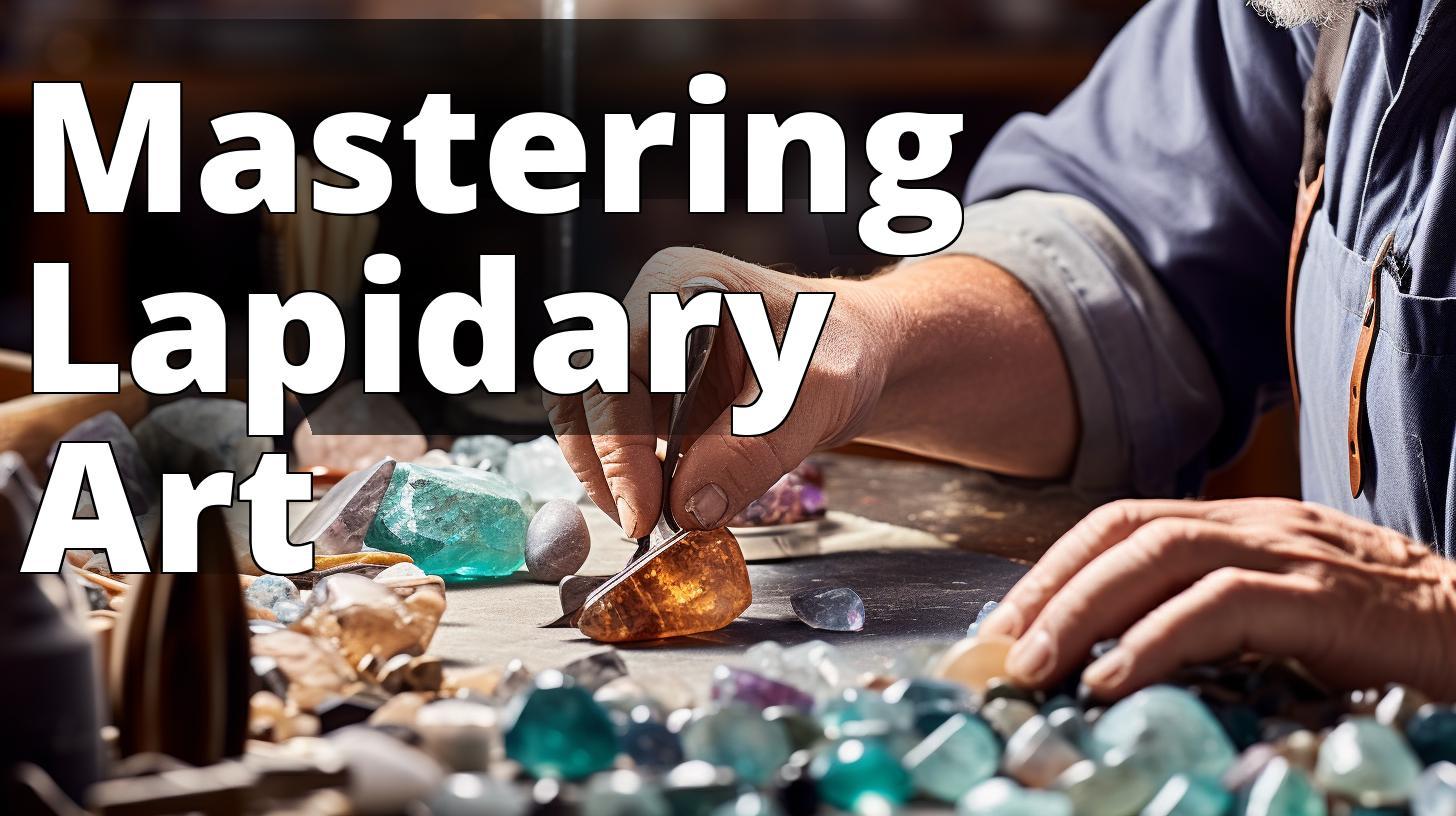Are you interested in creating unique and beautiful jewellery pieces that showcase the natural beauty of gemstones? If so, lapidary might just be the art form for you! Lapidary is the art of working with gemstones, and it has a rich history dating back to ancient times. In this article, we will provide a step-by-step guide to basic lapidary techniques for beginners. We will cover the four main techniques of lapidary: tumbling, cabbing, faceting, and carving. We will also discuss the tools and equipment needed for each technique, as well as safety tips and gemstone cutting techniques.
Lapidary is the art of working with gemstones, and it has a rich history dating back to ancient times. Today, lapidary is an essential part of jewelry making, allowing artists to create unique and beautiful pieces that showcase the natural beauty of gemstones.

Basic Lapidary Techniques for Beginners
- Lapidary art is the process of cutting, shaping, and polishing gemstones.
- The basic lapidary techniques for beginners are tumbling, cabbing, faceting, and carving.
- Each technique requires specific equipment, steps, and tips for success.
Basic Lapidary Techniques

A. Tumbling
Tumbling is the most basic and straightforward technique in lapidary. It involves placing rough gemstones into a tumbler with abrasive grit and water, and then tumbling them for several days until they are smooth and polished. Tumbling is an excellent technique for beginners because it requires minimal equipment and can be done with simple tools.
1. Equipment needed
To get started with tumbling, you will need a tumbler, abrasive grit, water, and rough gemstones.
2. Steps involved
The first step is to select the appropriate grit for your gemstones. Coarse grit is used for rough stones, while fine grit is used for finishing. You will then add the grit and water to the tumbler, along with your gemstones. Tumble the stones for several days, checking them periodically to ensure they are smoothing and polishing evenly. Once the stones are polished to your liking, rinse them thoroughly to remove any remaining grit.
3. Tips for success
Be patient and don’t rush the tumbling process. It can take several days to achieve a smooth and polished finish. Make sure to check the stones regularly and adjust the grit as needed. Don’t overload the tumbler with too many stones, as this can cause uneven polishing.

B. Cabbing
Cabbing is the process of shaping and polishing gemstones into a smooth, rounded shape called a cabochon. Cabbing is more advanced than tumbling, but it is still a great technique for beginners to learn.
1. Equipment needed
To get started with cabbing, you will need a cabbing machine, diamond wheels, water, and rough gemstones.
2. Steps involved
The first step is to select a rough gemstone and determine its best orientation for cutting. You will then use a diamond saw to cut the stone into a rough shape. Next, you will use a series of diamond wheels to shape and polish the stone into a smooth, rounded cabochon. Finally, you will polish the stone using a polishing pad and cerium oxide.
3. Tips for success
Be patient and take your time when cabbing. It can be a slow process, but the end result is well worth the effort. Make sure to keep the stone and wheels lubricated with water to prevent overheating. Use a light touch when shaping and polishing the stone to avoid chipping or cracking.

C. Faceting
Faceting is the most advanced and challenging technique in lapidary. It involves cutting and polishing gemstones with a high degree of precision to create sparkling, faceted gems.
1. Equipment needed
To get started with faceting, you will need a faceting machine, laps, diamond cutting tools, water, and rough gemstones.
2. Steps involved
The first step is to select a rough gemstone and determine its best orientation for cutting. You will then use a series of diamond cutting tools to cut and shape the stone into a faceted gem. Finally, you will polish the stone using a series of laps and diamond polishing compounds to achieve a high level of shine and sparkle.
3. Tips for success
Faceting is a challenging technique that requires both skill and patience. It can take several hours to cut and polish a single gemstone, so be prepared to invest a significant amount of time. Make sure to keep the stone and tools lubricated with water to prevent overheating. Use a light touch when cutting and polishing the stone to avoid chipping or cracking.
D. Carving
Carving is the process of creating intricate designs and shapes in gemstones using a variety of carving tools. It is a highly skilled technique that requires both artistic talent and knowledge of lapidary principles.
1. Equipment needed
To get started with carving, you will need a variety of carving tools, such as chisels, hammers, and grinders, as well as rough gemstones.
2. Steps involved
The first step is to select a rough gemstone and determine the design and shape you want to carve. You will then use a variety of carving tools to shape and carve the stone, working slowly and carefully to achieve the desired result. Finally, you will polish the stone using a series of laps and diamond polishing compounds to achieve a smooth and polished finish.
3. Tips for success
Carving is a highly skilled technique that requires both artistic talent and knowledge of lapidary principles. Be patient and take your time when carving, working slowly and carefully to avoid mistakes. Use a light touch when carving to avoid chipping or cracking the stone. Make sure to keep the stone and tools lubricated with water to prevent overheating.
Tools and Equipment
A. Overview of lapidary tools and equipment
Lapidary tools and equipment can vary widely depending on the technique you are using. For tumbling, you will need a tumbler and abrasive grit. For cabbing, you will need a cabbing machine, diamond wheels, and polishing pads. For faceting, you will need a faceting machine, laps, and diamond cutting tools. For carving, you will need a variety of carving tools, such as chisels, hammers, and grinders.
B. Basic tools needed for each technique
The basic tools needed for each technique are listed above, but there are also some additional tools that can be helpful, such as a dop stick for cabbing or a magnifying glass for faceting.
C. Advanced tools for experienced lapidary artists
Experienced lapidary artists may want to invest in more advanced tools, such as a high-end faceting machine or a variety of specialized carving tools.
D. Tips for buying high-quality tools
When buying lapidary tools, it is important to invest in high-quality equipment that will last for many years. Look for reputable brands and read reviews from other lapidary artists before making a purchase. Consider buying used equipment to save money, but make sure to inspect it carefully before buying.
Gemstone Cutting Techniques
A. Overview of gemstone cutting techniques
Gemstone cutting techniques can vary widely depending on the technique you are using. For cabbing, you will use a series of diamond wheels to shape and polish the stone into a smooth, rounded cabochon. For faceting, you will use a series of diamond cutting tools to cut and shape the stone into a faceted gem. For slicing, you will use a diamond saw to cut the stone into thin slices.
B. Cabbing
1. Steps involved
The steps involved in cabbing are listed above, but it is important to note that cabbing requires a high degree of skill and precision to achieve a smooth and polished finish.
2. Tips for success
The tips for success when cabbing are listed above, but it is important to note that cabbing requires a great deal of practice and patience to master.
C. Faceting
1. Steps involved
The steps involved in faceting are listed above, but it is important to note that faceting is the most advanced and challenging technique in lapidary.
2. Tips for success
The tips for success when faceting are listed above, but it is important to note that faceting requires a high degree of skill, patience, and precision to achieve a sparkling, faceted gem.
D. Slicing
1. Steps involved
The steps involved in slicing are relatively simple, but it is important to note that slicing requires a diamond saw and a great deal of care to avoid damaging the stone.
2. Tips for success
The tips for success when slicing are relatively simple, but it is important to note that slicing requires a great deal of care and precision to avoid damaging the stone.

Grinding, Sanding and Polishing Techniques
A. Overview of grinding, sanding, and polishing techniques
Grinding, sanding, and polishing are important techniques in lapidary that are used to shape and polish gemstones.
B. Equipment needed
To get started with grinding, sanding, and polishing, you will need a variety of grinding and sanding tools, as well as polishing pads and diamond polishing compounds.
C. Steps involved
The steps involved in grinding, sanding, and polishing can vary depending on the technique you are using, but the basic process involves using abrasive grit and polishing compounds to shape and polish the stone.
D. Tips for success
The tips for success when grinding, sanding, and polishing are to work slowly and carefully, use a light touch to avoid chipping or cracking the stone, and keep the stone and tools lubricated with water to prevent overheating.
Safety Tips
A. Overview of safety tips
Lapidary can be a safe and enjoyable hobby, but it is important to take safety precautions to avoid injury.
B. Protective gear
Wear protective gear, such as safety glasses, gloves, and a dust mask, to protect yourself from flying debris and harmful dust.
C. Safe work environment
Work in a clean, well-ventilated area, and keep all equipment and tools in good working condition.
D. Tips for safe lapidary work
The tips for safe lapidary work are to always follow the manufacturer’s instructions for equipment and tools, work slowly and carefully, and take breaks as needed to avoid fatigue.
Personal Experience: Importance of Safety in Lapidary Work
As a beginner lapidary artist, I learned the importance of safety measures the hard way. While working on a cabbing project, I didn’t wear protective gear, and a small piece of the stone broke off and hit me in the eye. Luckily, it wasn’t a serious injury, but it was a wake-up call for me to take safety seriously.
From then on, I invested in high-quality safety goggles, gloves, and a dust mask to protect myself from any potential hazards. I also made sure to work in a well-ventilated and well-lit area with a sturdy workbench.
Aside from protective gear, it’s important to be aware of the tools and equipment being used and their potential dangers. For instance, I learned the hard way that grinding wheels can shatter, causing serious injury. It’s crucial to inspect all tools before using them and to follow manufacturer instructions.
Taking these safety measures may seem tedious but they are crucial to enjoying lapidary work without any accidents or injuries. Remember to prioritize safety above all else to ensure a fun and stress-free lapidary experience.
Conclusion
In conclusion, lapidary is a fascinating and rewarding art form that allows artists to create beautiful and unique jewelry pieces. By following the step-by-step guide to basic lapidary techniques for beginners outlined in this article, you can get started with tumbling, cabbing, faceting, and carving. Remember to invest in high-quality tools and equipment, practice patience and precision, and always take safety precautions. With practice and dedication, you can become a skilled lapidary artist and create stunning gemstone jewelry pieces that will be treasured for a lifetime.


Leave a Reply